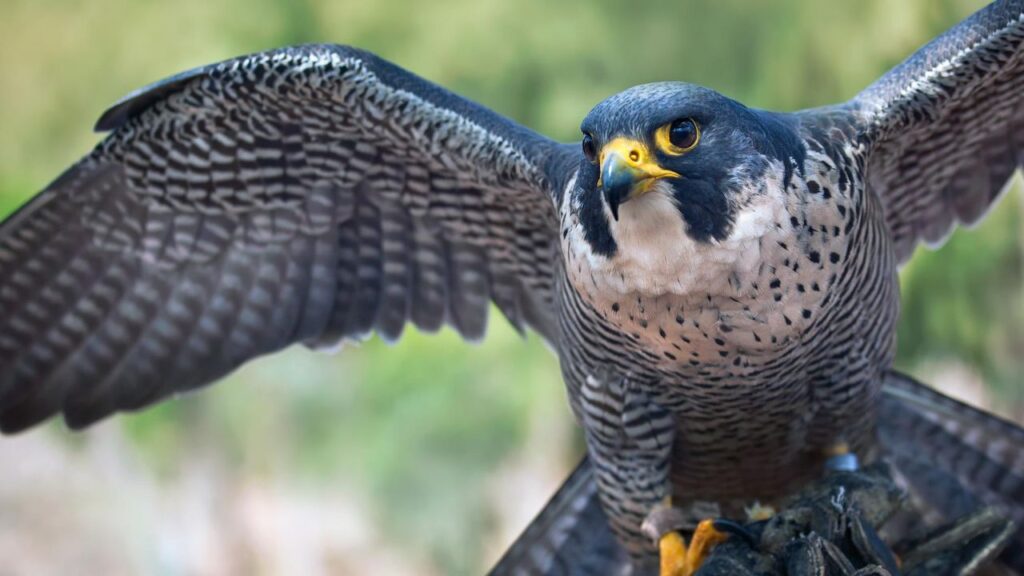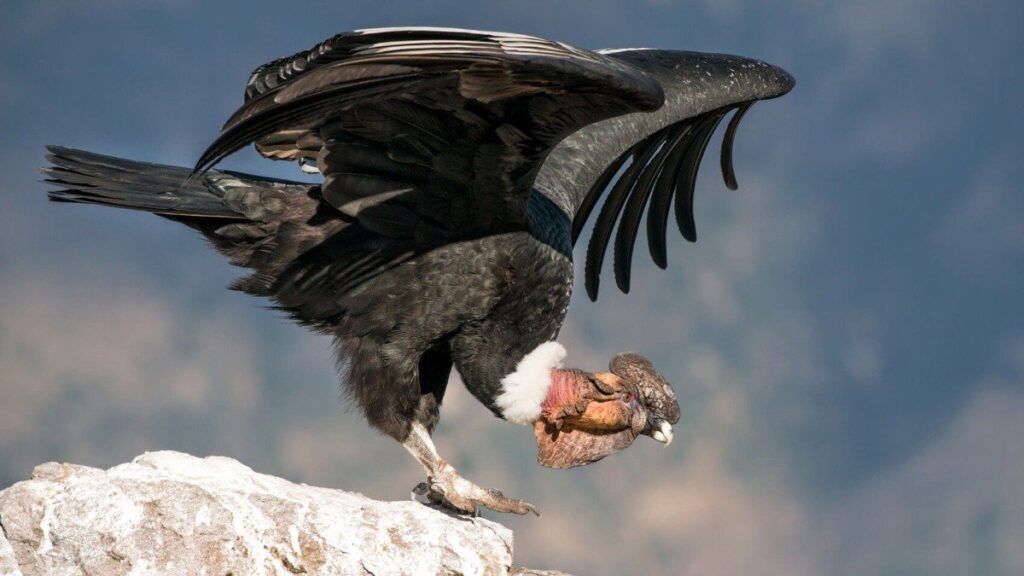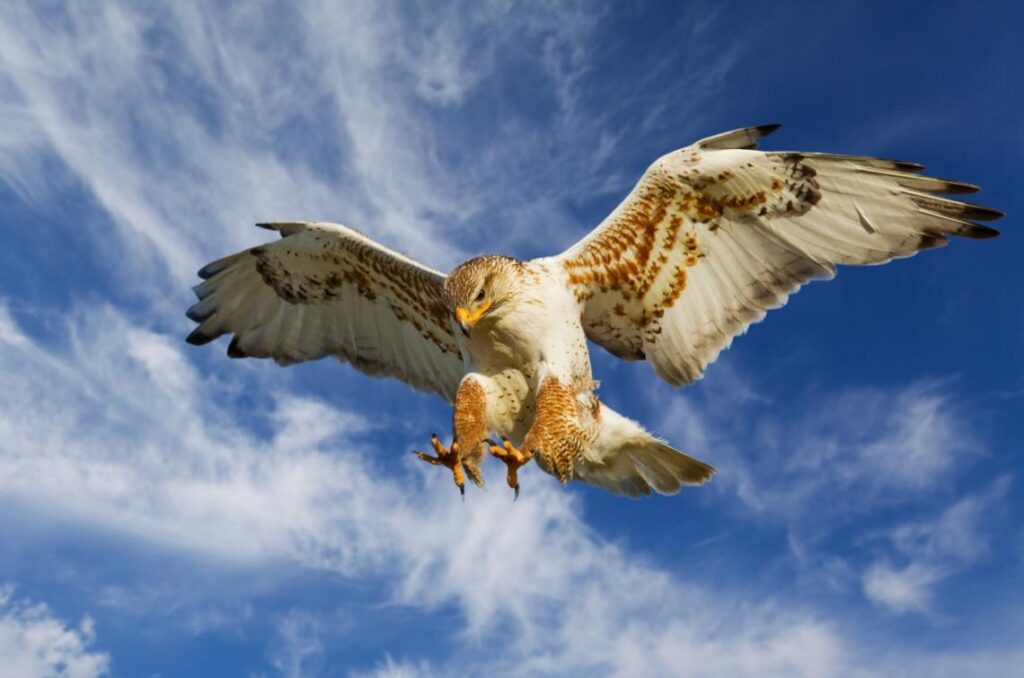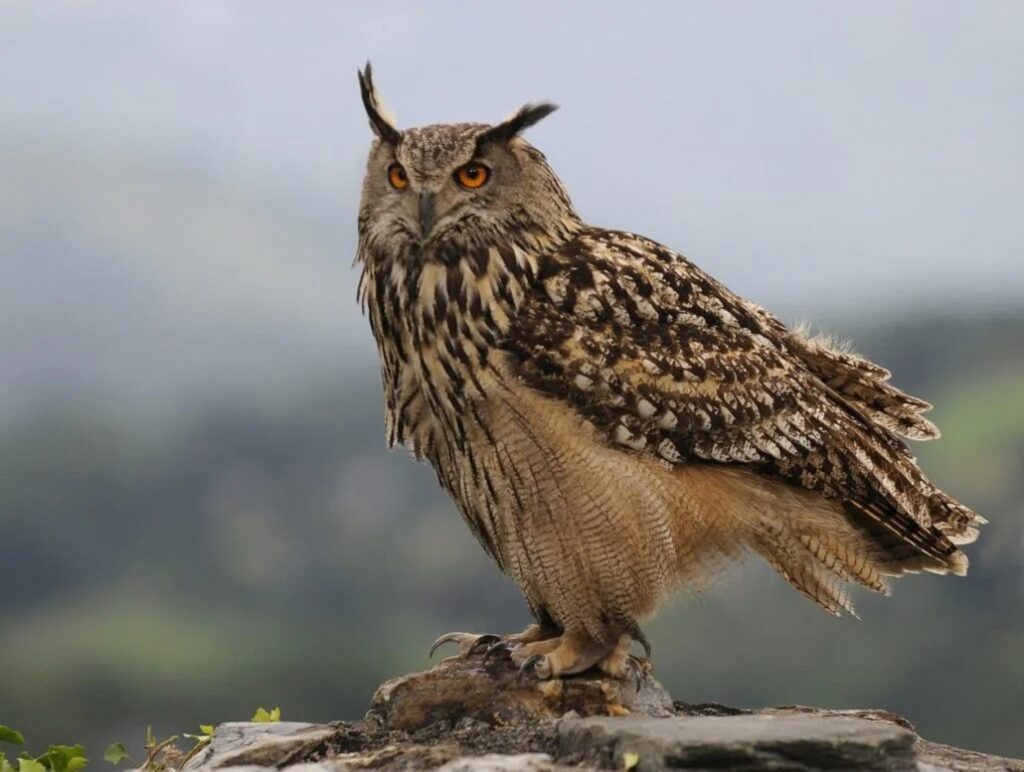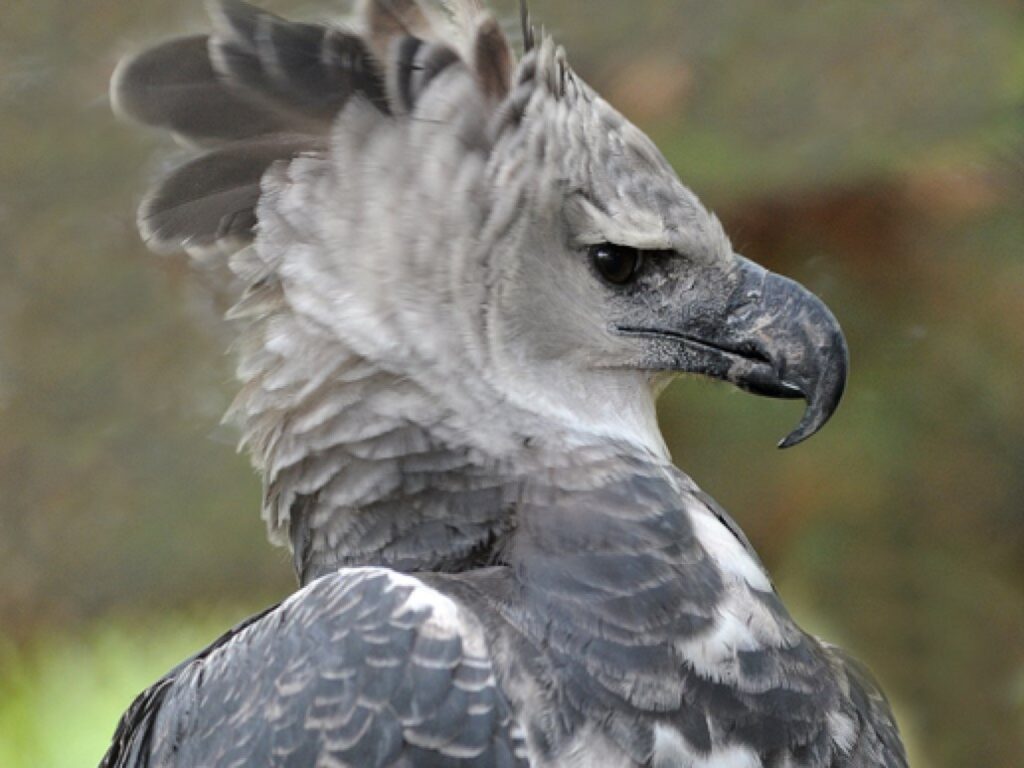Birds of Prey have a series of physical attributes that make them excellent predators of the air, which places them at the top of the food chain. Thanks to their sense of sight, beak, claws and other extraordinary qualities, they are relentless hunters when it comes to catching prey. To learn about the characteristics and examples of these powerful birds, we invite you to continue reading this article.
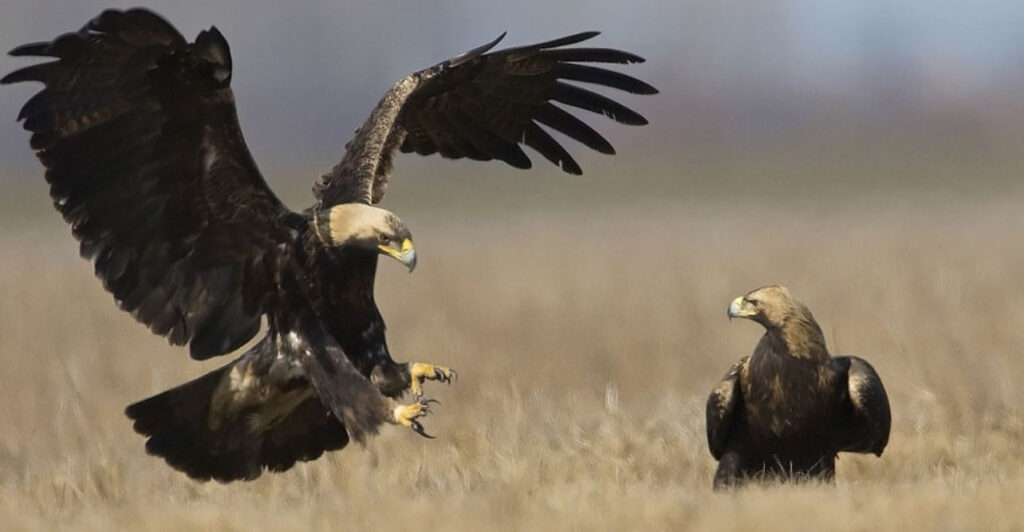
Birds of Prey or Raptors
There are thousands of kinds of birds, but one of the most striking groups of birds known is the birds of prey. In this group, which is also called birds of prey or birds of prey, a large number of species with impressive characteristics and prodigious beauty are included. A bird of prey or raptor is one that catches prey as food, using its beak and sharp claws. Both the latter and their beak are usually more or less large, powerful and adapted for tearing and/or piercing meat.
The word "raptor" comes from the Latin term "rapere", which means, "seize" or "take by force". Many species of birds can be considered partially or totally predators, however, in ornithology the word "bird of prey" is not only applied to birds that hunt and feed on animals, but also includes those that are they feed on very small insects
Main characteristics
Birds of prey, raptors or prey have common features, such as an extraordinary sense of sight with which they locate their prey as well as powerful claws with long nails and strong muscles. Its beak is often curved, hard and powerful. They usually exhibit a large complexion, although their heads are more or less small with huge eyes. Thanks to all these characteristics they are endowed with a superb and imposing beauty.
In general, their food consists of live prey, which varies according to the size of the bird that catches them. For example, a small bird of prey such as the kestrel can capture modest mammals, tiny birds and insects, while the golden eagle can capture micromammals, small and large mammals, which it exterminates with its powerful claws and beak, cutting and tearing their flesh with enormous ease.
Types of Birds of Prey
According to the competitive advantages offered by both their physical characteristics and adaptations and the availability of food in their environment, birds of prey usually exhibit diurnal or nocturnal habits:
diurnal birds
This set of birds has a wider diversity than the nocturnal ones. As part of them, the most famous are the eagles, considered the largest hunting birds and that can be found in all ecosystems. To it are added falcons and kestrels, as the fastest birds in the world. A special category of diurnal birds of prey are necrophagous birds, whose diet consists of carrion since this specimen does not kill its prey. They are birds of great weight and size, such as vultures and condors.
night birds
As part of this group are the strigids (owls) and titonids (owls). They are recognized for having adaptations that improve their hearing and reduce the noise of their wings when flying. These birds hunt at night, when the sense of hearing is of much greater importance than that of sight. Their face is rounded and their beak is short, which is helpful for a convenient concentration of the sound emitted by their prey, so they can hear any small movement.
Examples of Birds of Prey
Here are the reviews of some of the most well-known birds of prey that have distinctive characteristics:
Golden Eagle (Aquila chrysaetos)
It is known as one of the most famous and most widely distributed birds of prey on the planet. It can be found in North and Central America, Eurasia, and North Africa. Certain populations of importance can be found in Great Britain, Japan, Vancouver and the Mediterranean. The presence of the golden eagle in Central Europe has decreased due to human activity.
Eagle Owl (Bubo bubo)
Large bird of prey that can be found in various regions of Asia, Africa and Europe. It is usually present in northwestern Europe and in areas of the Mediterranean Sea such as the Iberian Peninsula. It populates various environments, being frequent in wooded, semi-desert and tundra areas. It is about 80 centimeters long and its wingspan is about 2 meters. A cryptic, marbled design covers its body and feathers as "ears". Since captive breeding of the Eurasian eagle owl is relatively easy, it is commonly used in falconry.
Eurasian Vulture (Torgos tracheliotus)
It is a bird of prey of enormous size endemic to Africa and is simply recognizable by its featherless neck and pinkish hue, very similar to a turkey. It has a powerful beak, much larger and stronger than that of other varieties of vultures, which allows this animal to dislodge and pierce the skin and muscles of already dead animals.
Common Sparrowhawk (Accipiter nisus)
The Eurasian Sparrowhawk is a bird of prey that can very frequently be found throughout Eurasia, from Spain to Japan, and is distinguished by its bluish-gray color with orange bands on its back. Although it is small in size, it has excellent qualities for hunting.
Peregrine Falcon (Falco peregrinus)
Undoubtedly, it is one of the most popular birds of prey, since it can be found all over the world and its adult specimens exhibit a bluish-gray back with a black head. It is the bird with the highest speed known, being able to exceed 300 kilometers per hour. The females of this species are larger than the males and their diet consists of reptiles, small mammals and insects.
European Owl (Athene noctua)
It is a bird that is barely 25 centimeters long and can be found in certain regions of Africa and Europe. The little owl is recognized by its yellow eyes, its rounded wings, like the rest of its body with brown plumage and white spots.
Barn Owl (Tyto alba)
This bird of prey inhabits the five continents, primarily in rural areas, plains with medium vegetation, and farmland. It is a medium-sized bird with nocturnal habits. The design of the barn owl's face contributes greatly to its extraordinary hearing acuity. It is a cosmopolitan variety that can reach about 40 centimeters in length. Its most notable feature is its beautiful white color with spots that dot its abdominal part.
Common Kestrel (Falco tinnunculus)
This is a medium-sized bird of prey with a greyish-brown head and russet wings with black markings. The common kestrel can be found in much of Europe, Asia and Africa, where it usually lives in low-lying thickets and cleared land.
Common Goshawk (Accipiter gentilis)
It is a bird with a great resemblance to a falcon or a sparrowhawk, but it is more closely related to eagles. The common goshawk can reach a size of 100 to 150 centimeters in length and exhibits a plumage of blackish or brown tones and a white abdomen with darker stripes. Its short wings are useful for moving through mountainous regions and the dense forests of Eurasia and America.
Andean Condor (Vultur gryphus)
It is a bird of enormous size and black color, with white feathers both on the neck and on the wings. It does not have feathers on its head, which is usually red, although it can change its color according to its emotional state. It lives in South America, particularly in the Andes Mountains.
Common Buzzard (Buteo buteo)
The Buzzard is a medium-sized bird of prey from Central Europe. It has a compact physique and a plumage whose colors range from dark brown to white tones. They are regularly found in grasslands, heaths and fields in central Europe.
bearded vulture (Gypaetus barbatus)
It is a vulture that is distinguished from other birds of prey. Its name originates from its habit of lifting bones and shells and throwing them against rocks to break them and feed on them. It is at risk of disappearing in Europe, where it can still be seen in the Cantabrian Mountains, the Pyrenees and the Alps. You can also get it in North Africa, South Africa and Greece.
Osprey (Pandion haliaetus)
This is a medium-sized bird of prey that lives on all continents except Antarctica, although in South America it is a migratory bird that does not build nests.
Short-eared Owl (Asio flammeus)
This is one of the most widely distributed owls in the world, with a relevant presence in the Antarctic Circle and South America, or in the Arctic Circle and the North Temperate Region. It has brown plumage on its upper part that turns pale in the lower part of the animal and a pair of very short ears on its flattened face and huge eyes.
Bald Eagle (Haliaeetus leucocephalus)
Native to North America and forms part of the order of the accipitiformes. It has a more or less large size, being able to reach 2 meters of wingspan. It is a top predator in the regions it inhabits, which can range from swamps and forests to desert areas. It frequently steals prey from the osprey (Pandion haliaetus), which it annoys and harasses. This is a very peculiar bird due to its size and the white hood on its head that characterizes it.
Harpy Eagle (Harpia harpyja)
It is one of the largest varieties of eagles that exists, reaching up to a meter in length, with a wingspan that exceeds two meters and with claws that can lengthen more than 15 centimeters. It is part of the order of the accipitiformes and lives in the rain forests of the Neotropics, from southern Mexico to northern Argentina. Very showy not only because of its enormous size, but also because of its plumage, which bristles in the area of the head when it feels under threat, simulating a kind of crown.
Giant Picargo (Haliaeetus pelagicus)
It is a bird of prey that inhabits regions of the sea, lakes or rivers in Japan, Korea, China and parts of Russia. It is the heaviest raptor since it can weigh more than 9 kilograms. Its wingspan exceeds 2 meters long and its length is more than one meter, which makes it, together with the harpy eagle, one of the largest birds in the world. Being a marine bird of prey, it feeds particularly on salmon, for which it has a huge beak suitable for severing the strong skin of these fish.
Barn Owl (Strix hylophila)
This kind of bird of prey inhabits jungles and forests of Brazil, Paraguay and Argentina. It is a very elusive bird that, on many occasions, it is easier to listen to it than to observe it. Medium-sized, about 40 centimeters long, it exhibits a very showy design with light and dark stripes that cover its body and a black disk on its face.
European Scops Owl (Otus scops)
This bird is found distributed throughout Europe, Asia and Africa. The Eurasian Scops Owl inhabits forests and areas near rivers, although it can also be observed in urban and peri-urban areas. It has very cryptic plumage, just like the rest of the strigiformes, and it is the smallest variety of owl in the Iberian Peninsula, barely 20 centimeters long. Therefore, it is considered one of the smallest birds of prey known.
Boreal Owl (Aegolius funereus)
This is a variety that populates northern Europe, being possible to observe it in areas of the Balkans, Pyrenees and the Alps, constituting the species of owl of mountains and coniferous forests par excellence. Its size is about 25 centimeters long, so it is considered one of the small birds of prey. It is recognized for having an extremely large head that is quite striking and with black stripes as "eyebrows" that surround its face.
Other Birds of Prey
In the following list we will mention other varieties of birds of prey that can be found in different parts of the world:
Águilas
- African Goshawk Eagle (Aquila spilogaster)
- Bonelli's Eagle (Aquila fasciata)
- Bold Eagle (Aquila audax)
- Cape Eagle (Aquila verreauxii)
- Moluccan Eagle (Aquila gurneyi)
- Steppe Eagle (Aquila nipalensis)
- Eastern Imperial Eagle (Aquila heliaca)
- Iberian Imperial Eagle (Aquila adalberti)
- Spotted Eagle (Clanga clanga)
- Indian Spotted Eagle (Clanga hastata)
- Spotted Eagle (Clanga pomarina)
- Raptor Eagle (Aquila rapax)
Owls
- Owl or Brown Tawny Owl (Strix virgata / Ciccaba virgata)
- Long-eared Owl (Asio otus)
- White Horned Owl (Lophostrix cristata)
- Great Horned Owl or American Eagle Owl (Bubo virginianus)
- Cape Owl (Bubo capensis)
- Barred Owl (Bubo shelleyi)
- Desert Owl (Bubo ascalaphus)
- Philippine Owl (Bubo philippensis)
- Milky Owl or Verreaux's Owl (Bubo lacteus)
- Magellanic Owl or Great Horned Owl (Bubo magellanicus)
- Spotted Owl (Strix occidentalis)
- Great Owl (Asio capensis)
- Nduk Owl, Guinea Owl or Fraser's Owl (Bubo poensis)
- Snowy Owl (Bubo scandiacus)
- Bengal Eagle Owl (Bubo bengalensis)
- Malayan Eagle Owl (Bubo sumatranus)
- Vermiculated Owl or Ashy Owl (Bubo cinerascens)
kestrels
- Australian Kestrel (Falco cenchroides)
- Madagascar Kestrel (Falco newtoni)
- Mauritius Kestrel (Falco punctatus)
- Seychelles Kestrel (Falco araeus)
- Black-backed Kestrel or Dickinson's Kestrel (Falco dickinsoni)
- Slaty or Gray Kestrel (Falco ardosiaceus)
- Malagasy Kestrel (Falco zoniventris)
- White-eyed Kestrel (Falco rupicoloides)
- Red-footed Kestrel (Falco vespertinus)
- Lesser Kestrel (Falco naumanni)
- Fox Kestrel (Falco alopex)
Hawks
- Berigora falcon (Falco berigora)
- Borni Falcon (Falco biarmicus)
- Eleanor's falcon (Falco eleonorae)
- Taita Falcon (Falco fasciinucha)
- Maori Falcon (Falco novaeseelandiae)
- Mexican Falcon or Pale Falcon (Falco mexicanus)
- Bat Falcon (Falco rufigularis)
- Red-breasted Falcon or Large Black Falcon (Falco deiroleucus)
- Plumed Falcon (Falco femoralis)
- Saker Falcon (Falco cherrug)
- Tagarote Falcon (Falco pelegrinoides)
- Yággar falcon (Falco jugger)
little owls
- Collared Owl (Glaucidium brodiei)
- Amazonian Owl (Glaucidium hardyi)
- Andean Owl (Glaucidium jardinii)
- Cinnamon Owlet (Aegolius harrisii)
- Central American Owl (Glaucidium griseiceps)
- Little or Alpine Owl (Glaucidium passerinum)
- Costa Rican Owl (Glaucidium costaricanum)
- Blewitt's Owlet (Athene blewitti / Heteroglaux blewitti)
- Guatemalan Owl (Glaucidium cobanense)
- Gnome Owl (Glaucidium gnoma)
- Jungle Owl (Glaucidium radiatum)
- Saguaro Owl or Pygmy Owl (Micrathene whitneyi)
- Burrowing Owl (Athene cunicularia)
- Cape Owl (Glaucidium capense)
- Least Owl (Glaucidium minutissimum)
- Pearly Owl (Glaucidium perlatum)
- Red-breasted Owl (Glaucidium tephronotum)
Other Birds of Prey
- African Falcon (Falco cuvierii)
- Australian Hawk (Falco longipennis)
- Eurasian Falcon (Falco subbuteo)
- Eastern Falcon (Falco severus)
- Turumti Falcon (Falco chicquera)
- Alcotán Unicolor or Opaque or Slate Falcon (Falco concolor)
- Savannah Aura (Cathartes burrovianus)
- Jungle Aura (Cathartes melambrotus)
- Choliba Scops Owl (Megascops choliba)
- Guatemalan Scops Owl (Megascops guatemalae)
- Pacific Scops Owl (Megascops cooperi)
- American Red-headed Vulture (Cathartes aura)
- Rusty Buzzard or Ferruginous Hawk (Buteo regalis)
- Griffon Vulture (Gyps fulvus)
- American Black Vulture (Coragyps atratus)
- Little Caburé or Caburé Owl (Glaucidium brasilianum)
- Tawny Owl Sparrowhawk (Surnia ulula)
- Chuncho (Glaucidium nana)
- California condor (Gymnogyps californianus)
- Royal Condor (Sarcoramphus papa)
- Merlin (Falco columbarius)
- Gyrfalcon or Gyrfalcon (Falco rusticolus)
- Great Horned Owl or Nacurutu (Bubo virginianus nacurutu)
- Spectacled Owl (Pulsatrix perspicillata)
- Long-eared Owl (Asio or Pseudoscops clamator)
- Screaming Picargo (Haliaeetus vocifer)
- Secretary (Sagittarius serpentarius)
- Siguapa, Ciguapa or Blackish Owl (Asio stygius)
State of conservation
Despite the fact that birds of prey currently have legal protection, this was not the case at all times, since years ago they were considered harmful animals, either because of their impact on species bred by man or on those that were prey. of them, which is why they were classified as vermin.
In Europe, the period of the two world wars, meant a truce in the hunting of raptors and, later, from the 1950s and 1960s, the protection of this group of birds began, which could be verified in a slight increase in their populations in the 1970s. In Spain, birds of prey have been legally protected since 1966.
Because of their predatory lifestyle, often at the top of the food chain, birds of prey face different conservation circumstances. Pollution has caused severe declines in some species. The use of pesticides such as DDT at all levels, and their absorption by the organisms of their potential prey, has caused the egg shells of these birds to progressively thin.
Similarly, the decrease in its habitat due to the human impact on its environment as well as the mass disappearance of prey such as rabbits, caused by epidemics such as viral hemorrhagic pneumonia and myxomatosis, caused a severe drop in certain populations of birds of prey. , reaching almost 80% of areas unoccupied by the Iberian imperial eagle.
Falconry
The activity of hunting with the use of birds of prey is called falconry, which had its beginnings more than four thousand years ago. Although it was very common during the Middle Ages, it disappeared in the XNUMXth century. At present, one of its most important promoters and the one who insisted on its rescue was Félix Rodríguez de la Fuente, one of the greatest raptor experts in the world.
Other articles that may also interest you are:
